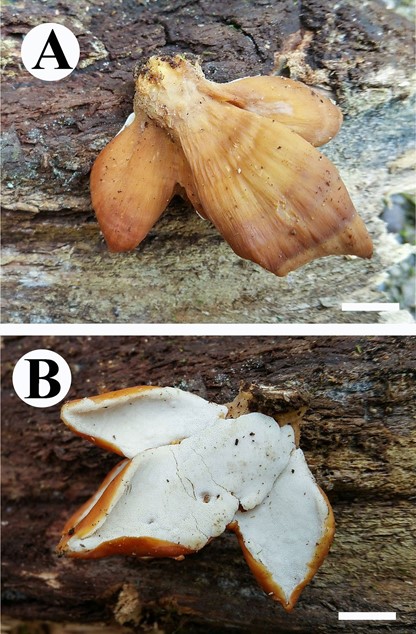Rhomboidia wuliangshanensis C.L. Zhao, sp. nov. Figs 2, 3
MycoBank number: MB 833320; Index Fungorum number: IF 833320; Facesoffungi number: FoF;
Differs from Nigroporus vinosus by its stipitate to substipitate basidiomata and monomitic hyphal structure.
Type: China. Yunnan Province: Puer, Jingdong County, Wuliangshan National Nature Reserve, on angiosperm trunk, 6 Oct 2017, CLZhao 4406 (Holotype, SWFC 0004406; GenBank MK860715, MK860710).
Etymology: The specific epithet wuliangshanensis (Lat.) refers to the type locality, Wuliangshan.
Basidiomata annual, stipitate to substipitate. Pileus rhomboid, arising from a multiple branched stipe, edges curling slightly inward, 3.5 cm from the base to margin, 4 cm wide, up to 3 mm thick; pileus surface radially striate, slightly brown to orange brown when fresh, drying brown to reddish; the margin acute, entire. Pore surface white when fresh, cream to buff upon drying. Pores angular, 7–9 per mm, dissepiments thin, entire. Context corky, white, thin, up to 0.5 mm thick. Tubes concolorous with pore surface, corky, up to 2.5 mm long. –Type of rot: white rot.
Additional specimen examined: CHINA. YUNNAN pRovINcE. Puer: Jingdong County, Wuliangshan National Nature Reserve, on angiosperm trunk, 6 Oct 2017, CLZhao 4411 (SWFC 004411; GenBank MK860716, MK860711).

Fig. 2. Rhomboidia wuliangshanensis (holotype, SWFC 0004406). Scale bars = 5 mm.

Fig. 3. Rhomboidia wuliangshanensis (drawn from the holotype, SWFC 0004406). A. Basidiospores; B. Basidia and basidioles; C. Cystidioles; D. Hyphal ends; E. Hyphae from trama; F. Hyphae from subiculum. Scale bars: a = 5 µm; b–f = 10 µm.
